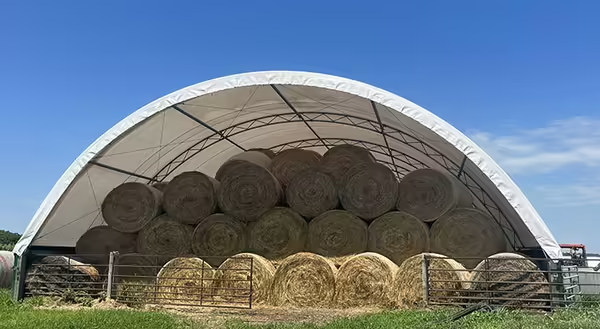
The foundation of a least-cost, balanced winter ration starts with a forage test. For those buying or selling hay, forage testing can play an even bigger role in pricing and purchasing value.
Sample in lots
A ‘lot’ is defined as forages from the same field, harvested at similar times, and is handled and stored in the same way. Forage quality differs between cuttings. Identify different cuttings and separate fields to allow for uniform lot sampling.
How to Sample
To obtain the best representative sample, use a hay probe/core sampler that is at least 12 inches long and 3/8-5/8 inches in diameter, with a sharp edge.
For round bales, insert the probe through the rounded edge of the bale. Randomly sample 15 to 20 bales, depending on the lot size.
For square bales, sample from the square end. Randomly sample at least 10 bales, making sure to sample different sides throughout to account for storage differences.
Place samples in a sealed plastic bag. Store in a cool, dry environment until analysis can be done. Label the bags with your name, address, lot identification, and date. It is important to send the sample as soon as possible to avoid drying out and altering results.
A standard test should be sufficient to understand forage quality. The key results will be moisture, protein, and energy. Consult your nutritionist or feed supplier to ensure results allow least-cost, balanced ration formulation. There are several certified forage testing labs in the Midwest that will provide hay testing services.
Interpreting results
Key definitions and abbreviations:
Dry Matter (DM): The percentage of sample that is not water. This will allow comparison between feedstuffs. 85% is ideal for dry hay.
Acid Detergent Fiber (ADF): A measure of the least-digestible plant carbohydrates. Higher ADF would be correlated with less digestibility. Lower numbers indicate better digestibility.
Neutral Detergent Fiber (NDF): Inversely correlated to intake potential. Higher NDF would mean lower forage intake potential.
Total Digestible Nutrients (TDN): A measure of energy value. The greater the value, the higher the energy. Less mature forages will have higher TDN. As ADF and NDF increase, TDN decreases. Throughout life stages, cattle will have different energy requirements. A dry cow will require ~48% TDN whereas a lactating cow will require ~60% or more.
Crude Protein (CP): An estimate of protein content. This is calculated using the nitrogen content, which is highly dependent on forage species and maturity. In a beef herd, protein requirements are dependent on stage of life and lactation.
Relative Forage Quality (RFQ): An index to compare quality. This combines ADF and NDF. The typical range is 50 to 250. The higher the number, the higher the quality.
Contact your local Extension service or nutritionist to obtain forage samples and nutrient analysis to formulate a balanced ration.
*Originally published in Progressive Cattle